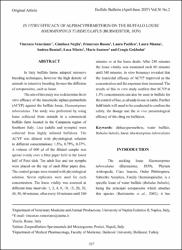In vitro efficacy of alphacypermethrin on the buffalo louse Haematopinus tuberculatus (Burmeister, 1839)

Göster/
Erişim
info:eu-repo/semantics/openAccessTarih
2017Yazar
Veneziano, VincenzoNeglia, Gianluca
Buono, Francesco
Pacifico, Laura
Manna, Laura
Santoro, Mario
Gökbulut, Cengiz
Üst veri
Tüm öğe kaydını gösterÖzet
In Italy buffalo farms adopted intensive breeding techniques, however the high density of animals in intensive breeding favours the diffusion of ectoparasites, such as louse. The aim of this study was to determine the in vitro efficacy of the insecticide alphacypermethrin (ACYP) against the buffalo louse, Haematopinus tuberculatus. The study was performed by using louse collected from animals in a commercial buffalo farm located in the Campania region of Southern Italy. Lice (adults and nymphs) were collected from highly infested buffaloes. The ACYP was diluted with physiological solution to different concentrations: 1.5%, 0.75%, 0.37%. A volume of 600 µl of the diluted sample was spread evenly over a filter paper held in the lower half of Petri dish. Ten adult lice and ten nymphs were placed on the top of each filter paper disc. The control groups were treated with physiological solution. Seven replicates were used for each concentration. The louse vitality was assessed at different time intervals: 1, 2, 4, 8, 10, 15, 20, 30, 40, 50, 60 minutes, after every 10 minutes until 240 minutes or at the louse death. After 240 minutes the louse vitality was examined each 60 minutes until 540 minutes. In vitro bioassays revealed that the lousicidal efficacy of ACYP improved as the concentration and the exposure time increased. The results of this in vitro study confirm that ACYP at 1.5% concentration can also be used in buffalo for the control of lice, as already in use in cattle. Further field trials will need to be conducted to confirm the safety, the dosage and the in vivo parasitological efficacy of this drug on buffaloes.

















